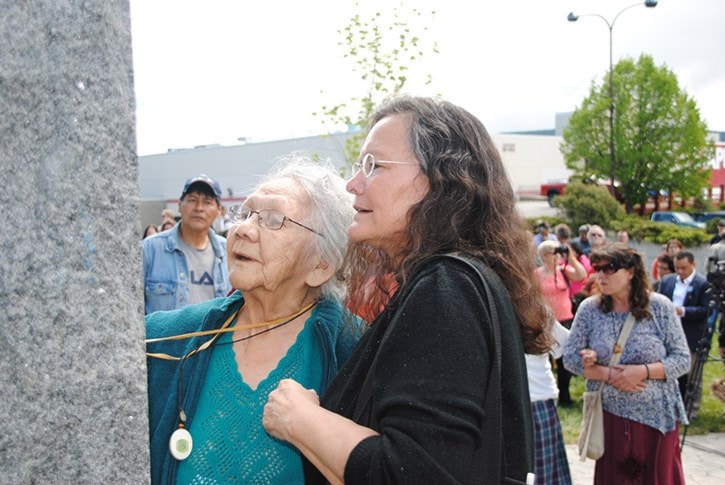After unveiling the second of two monuments honouring those lost to and survivors of residential schools, Esk’etemc Chief Fred Robbins looked around to the hundreds of people gathered in Boitanio Park and suggested the challenge now is to create a new legacy.
“It’s very interesting that we have an opportunity here. If we don’t continue this relationship the next generation is going to look back at us and ask why we didn’t do something when we had the chance.”
Robbins began gathering momentum for a St. Joseph’s Mission Residential School commemorative project a year and a half ago, and began working with local government, the school district, and First Nations leaders.
The timing of unveiling a monument at the former school site, and in Boitanio Park, coincided with Truth and Reconciliation Commission hearings in Williams Lake and a reunion over the May long weekend of former St. Joseph’s students.
“I see many chiefs, many councillors, that are here to participate and bear witness that we’re ready to move forward and build a relationship, and build a new legacy for First Nations people, not one based on mistrust,” Robbins said.
“This is the people that are going to make the change happen. If we allow ourselves to put up a monument and say that we’re done we’re just shifting back where we were five years ago. We need to start moving that economic driver that will create something for the First Nations, the regional district, and the mayors.”
Williams Lake Indian Band Chief Ann Louie said even those who have not attended residential school feel the impact.
“Our children feel it, our grandchildren feel it. Today and yesterday was the beginning of a very small step in reconciliation between all communities and the residential schools that have impacted our First Nations people,” Louie said.
“There are high numbers of incarceration and low levels of education amongst our First Nations people, and a high number of children in care.”
Those are direct results of the impacts of residential schools, she added.
“We need to find some way to break that cycle and having our people become healthy. It’s an interesting and long journey,” Louie said.
Mayor Kerry Cook said the monuments are both a reminder and a challenge.
“They remind us that we have a responsibility to decide how we are going to move forward. I want a city where all people feel welcome and are respected. It’s long overdue.”
Cariboo Regional District chair Al Richmond said the monument remembers those who didn’t survive residential schools, those who did survive, and those who are still striving to survive.
“When a family walks into the park, a child will ask what the monument is about,” Richmond said. “I’m hoping if we do our job right, they’ll have the answer, that they’ll suggest this is something that happened, we want to be sure it never, ever, happens again. Never, can’t, won’t.”
By understanding the past, the region can build a future together, Richmond added.
